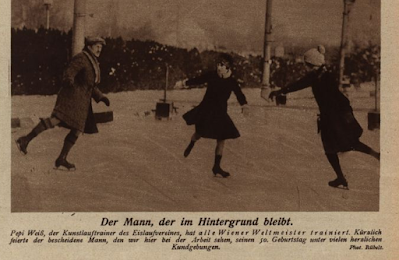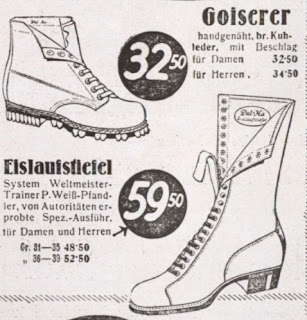"Without him we wouldn't have a [winner]. The Vienna School owes him a lot." - "Neue Freie Presse", February 25, 1927
Josef 'Pepi' Weiß-Pfändler was born in Vienna, Austria in 1880. He first took to the ice at the Cottage Eislaufverein at the age of eleven. Two years later, he began skating at Eduard Engelmann's rink in Hernals and in 1896, he joined the Training-Eis-Klub. That same winter, he entered his first speed skating competition on the frozen Danube river, winning a five hundred meter race, backwards skating race and obstacle course. His successes as a speed skater continued through the Edwardian era. In 1913, he won his last five hundred and fifteen hundred meter races and was awarded the Pollak-Parnegg-Preis.

It wasn't until the age of thirty three, when he retired from speed skating, that Pepi started seriously pursuing speed skating. He started training for the 1914 European Championships, which were to be held in Vienna, but was talked out of it by the Österreichischer Eislauf-Verband's future President Hans Pfeiffer, who felt he could best serve the sport as an instructor. After one winter teaching at the Engelmann rink just before the Great War, he took a position as the head trainer at the prestigious Wiener Eislaufverein.
Top: Pepi Weiß-Pfändler and Fritzi Burger. Bottom: Ludwig Wrede, Herma Szabo, Pepi Weiß-Pfändler and Willy Böckl.
From the early twentieth century until World War II, Austrian skaters dominated the international figure skating scene, bringing home dozens of medals at the European and World Championships... and Pepi had a hand in coaching nearly all of them. Over the years, he was the trainer of no less than thirteen Olympic Medallists:
Karl Schäfer, Herma Szabo and Ludwig Wrede,
Willy Böckl, Helene Engelmann and Alfred Berger,
Fritzi Burger,
Lilly Scholz and Otto Kaiser,
Melitta Brunner, Felix Kaspar and
Ilse and Erik Pausin. At one point or another, he also gave lessons to a fourteenth Olympic Gold Medallist,
Sonja Henie.
Pepi Weiß-Pfändler and Fritzi Burger
After the Great War, Pepi worked with several pre-War champion skaters, including World Champions Gilbert Fuchs and Fritz Kachler and European Champion Ernst Herz. His other students included Karl Mejstrik, Idi Papez and Karl Zwack, Hilde Holovsky,
Paula Zalaudek, Grete Lainer,
Hedy Stenuf, Hanne Niernberger,
Erich Erdös, Ilse Hornung,
Liselotte Landbeck,
Gisela Reichmann, Dr. Hugo Distler, Herbert Alward, Emil and Herta Ratzenhofer,
Otto Preißecker and Ernst Oppacher. Skaters that Pepi taught won over eighty medals at the World Championships - a record that no modern coach can come to close to touching. It's important to recognize that the coach/skater relationships in Pepi's day weren't the same as today. There was no coach travelling to every competition, sitting in a kiss n' cry area and holding their skate guards. They were largely self-sufficient, but the intermittent lessons they had with their trainers in between these competitions played a very important role in their development.
In an interview with Harrington E. Crissey Jr. for "The Journal of the Figure Skating Historical Society" in 1994, Melitta Brunner recalled, "Weisz was paid a salary by the Wiener Eislauf Verein rather than having his students pay him. He wouldn't just take anyone under his wing; he would send out talent scouts on the rink - it was a very large rink, one of the biggest in Europe. The scouts, who were skaters who taught the general public, would comb the rink for children with ability. These children were taken to a special portion of the rink for training on a two-week trial basis. If Weisz didn't feel the chid merited instruction, he or she would be let go. That's how Vienna became so well known for its skating instruction. People from all over the world studied at the Wiener Eislauf Verein. One day, right after the Chamonix Olympics of 1924, a young girl showed up to have lessons with Pepi Weisz. When I asked who the girl was, I learned she had skated in the Olympics and finished last. I thought she looked very good. It was Sonja Henie. Wilhelm Henie, Sonja's father, was a top Norwegian fur merchant and a smart guy. When the 1924 Olympics ended, he asked where Herma Szabo, the gold medalist, had trained and found that she studied with Weisz at the Wiener Eislauf Verein; so he headed there and stayed at the Imperial Hotel. He used Sonja to help his business by dressing her up in a mink coat and fur hats and while Sonja had daily lessons from Weisz for a month, Papa Henie took orders from Viennese fur merchants."

Lilly Weiller, Pepi Weiß-Pfändler, Fritzi Burger, Ilse Hornung and Edith Hecht
The skaters that listened to Pepi clearly succeeded, and unfortunately one skater who didn't paid the ultimate price. In November of 1934, Pepi expressly forbade a twenty-three year old ice clown named Oskar Loschitz from practicing a somersault on the ice. Oskar waited until Pepi wasn't around, tried it anyway and smashed his head. He was taken to the hospital and died of cerebral bleeding not long after.
The Eislaufstlefel, a brand of skating boots endorsed by Pepi in the thirties
Pepi's talents extended far beyond figure and speed skating. He also worked with Vienna's hockey teams and speed skaters and enjoyed playing bandy, hunting, skiing, cycling, fencing, boxing and wrestling. He was a member of the Danube rowing team and by all accounts, and excellent marksman. His greatest love, however, was music. For over thirty years, he played the cornet and flugelhorn with the Wiener Volksoper orchestra.
In 1934, Pepi was honoured by the Wiener Eislaufverein for his twenty years of service, "care and tireless zeal". He retired a few years later, leaving the club's skaters in the hands of Gustav Hügel and Anton Steiner. He passed away after a long illness on May 25, 1939 at the age of fifty-nine. Two months before his death, Vienna's Vice-Mayor presented him with a certificate on behalf of the city, noting his contribution to skating in Austria. Sadly, since his death, his contributions to the sport have gone almost completely unnoticed... and he's yet to have been inducted to the World Figure Skating Hall Of Fame.
Skate Guard is a blog dedicated to preserving the rich, colourful and fascinating history of figure skating. Over ten years, the blog has featured over a thousand free articles covering all aspects of the sport's history, as well as four compelling in-depth features. To read the latest articles, follow the blog on Facebook, Twitter, Pinterest and YouTube. If you enjoy Skate Guard, please show your support for this archive by ordering a copy of the figure skating reference books "The Almanac of Canadian Figure Skating", "Technical Merit: A History of Figure Skating Jumps" and "A Bibliography of Figure Skating": https://skateguard1.blogspot.com/p/buy-book.html.







